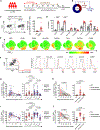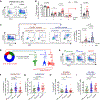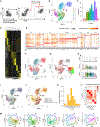Distinct features of a peripheral T helper subset that drives the B cell response in dengue virus infection
- PMID: 40073863
- PMCID: PMC12032839
- DOI: 10.1016/j.celrep.2025.115366
Distinct features of a peripheral T helper subset that drives the B cell response in dengue virus infection
Abstract
Dengue-virus-induced humoral immunity can increase the risk of severe disease, but the factors influencing this response are poorly understood. Here, we investigate the contribution of CD4+ T cells to B cell responses in human dengue infection. We identify a dominant peripheral PD-1+ T cell subset that accumulates in severe patients and could induce B cell differentiation via interleukin-21 (IL-21)-related pathway. Single-cell analyses reveal heterogeneity within PD-1+ cells, demonstrating the coexistence of subsets with "helper" (IL-21+) or "cytotoxic" characteristics. The IL-21+ subset displays a distinct clonotypic and transcriptomic signature compared to follicular helper T cells and persists as a memory in lymph nodes. Notably, we show that the IL-21+ subset seems to majorly drive the extrafollicular B cell responses in dengue. Our study establishes the peripheral IL-21+ subset as a potential determinant of the humoral response to dengue virus infection. These findings provide important insights into the T-cell-dependent regulation of humoral responses and can inform the design of effective dengue vaccines.
Keywords: CP: Immunology; CP: Microbiology; IL-21; PD-1(+) T helper; T cell clonotypes; T cell-B cell collaboration; T follicular helper; antibody response; dengue; extrafollicular B cells; humoral immunity; single-cell transcriptomics.
Copyright © 2025 The Author(s). Published by Elsevier Inc. All rights reserved.
Conflict of interest statement
Declaration of interests N.G. and A.A. are listed as inventors on patents submitted by the National Institute of Immunology and cover the use of the “T cell qualitative assay” for vaccine evaluation. N.G. has filed patent protection for the use of dengue virus Tfh epitopes identified in the Indian population. D.W. is a consultant for Moderna. La Jolla Institute for Immunology has filed for patent protection for various aspects of T cell epitopes and vaccine design work. A.S. is a consultant for GritstoneBio, FlowPharma, Moderna, AstraZeneca, Qiagen, Fortress, Gilead, Sanofi, Merck, RiverVest, MedaCorp, Turnstone, NAVaccine Institute, Emervax, GersonLehrman, and Guggenheim.
Figures







References
-
- Halstead SB, Chow JS, and Marchette NJ (1973). Immunological enhancement of dengue virus replication. Nat. New Biol. 243, 24–26. - PubMed
-
- Sangkawibha N, Rojanasuphot S, Ahandrik S, Viriyapongse S, Jatanasen S, Salitul V, Phanthumachinda B, and Halstead SB (1984). Risk factors in dengue shock syndrome: a prospective epidemiologic study in Rayong, Thailand. I. The 1980 outbreak. Am. J. Epidemiol. 120, 653–669. 10.1093/oxfordjournals.aje.a113932. - DOI - PubMed
MeSH terms
Substances
Grants and funding
LinkOut - more resources
Full Text Sources
Medical
Research Materials
Miscellaneous

